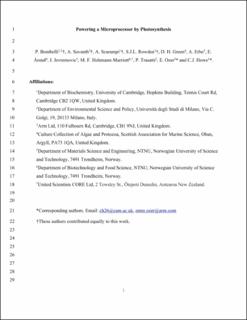| dc.contributor.author | Bombelli, Paolo | |
| dc.contributor.author | Savanth, Anand | |
| dc.contributor.author | Scarampi, Alberto | |
| dc.contributor.author | Rowden, Stephen J.L. | |
| dc.contributor.author | Green, David H. | |
| dc.contributor.author | Erbe, Andreas | |
| dc.contributor.author | Årstøl, Erland | |
| dc.contributor.author | Jevremovic, Ivana | |
| dc.contributor.author | Hohmann-Marriott, Martin Frank | |
| dc.contributor.author | Trasatti, Stefano P. | |
| dc.contributor.author | Ozer, Emre | |
| dc.contributor.author | Howe, Christopher J. | |
| dc.date.accessioned | 2022-10-18T14:09:43Z | |
| dc.date.available | 2022-10-18T14:09:43Z | |
| dc.date.created | 2022-06-18T22:02:33Z | |
| dc.date.issued | 2022 | |
| dc.identifier.citation | Energy & Environmental Science. 2022, 15 2529-2536. | en_US |
| dc.identifier.issn | 1754-5692 | |
| dc.identifier.uri | https://hdl.handle.net/11250/3026741 | |
| dc.description.abstract | Sustainable, affordable and decentralised sources of electrical energy are required to power the network of electronic devices known as the Internet of Things. Power consumption for a single Internet of Things device is modest, ranging from μW to mW, but the number of Internet of Things devices has already reached many billions and is expected to grow to one trillion by 2035, requiring a vast number of portable energy sources (e.g., a battery or an energy harvester). Batteries rely largely on expensive and unsustainable materials (e.g., rare earth elements) and their charge eventually runs out. Existing energy harvesters (e.g., solar, temperature, vibration) are longer lasting but may have adverse effects on the environment (e.g., hazardous materials are used in the production of photovoltaics). Here, we describe a bio-photovoltaic energy harvester system using photosynthetic microorganisms on an aluminium anode that can power an Arm Cortex M0+, a microprocessor widely used in Internet of Things applications. The proposed energy harvester has operated the Arm Cortex M0+ for over six months in a domestic environment under ambient light. It is comparable in size to an AA battery, and is built using common, durable, inexpensive and largely recyclable materials. | en_US |
| dc.language.iso | eng | en_US |
| dc.publisher | Royal Society of Chemistry | en_US |
| dc.title | Powering a Microprocessor by Photosynthesis | en_US |
| dc.title.alternative | Powering a Microprocessor by Photosynthesis | en_US |
| dc.type | Peer reviewed | en_US |
| dc.type | Journal article | en_US |
| dc.description.version | acceptedVersion | en_US |
| dc.rights.holder | This is the authors' accepted manuscript to an article published by Royal Society of Chemistry. Locked until 12/5-2023 due to copyright restrictions. The final authenticated version is available online at: http://dx.doi.org/10.1039/d2ee00233g | en_US |
| dc.source.pagenumber | 2529-2536 | en_US |
| dc.source.volume | 15 | en_US |
| dc.source.journal | Energy & Environmental Science | en_US |
| dc.identifier.doi | 10.1039/d2ee00233g | |
| dc.identifier.cristin | 2033144 | |
| cristin.ispublished | true | |
| cristin.fulltext | postprint | |
| cristin.qualitycode | 1 | |
